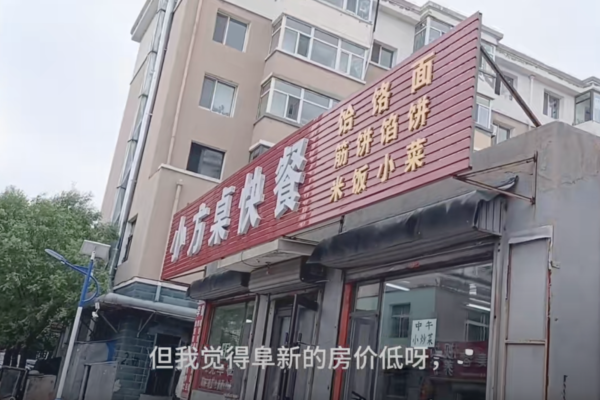In recent years, the “cabbage price” houses in Fuxin City, Liaoning Province, have attracted young people from other places to come and buy houses in Fuxin. However, due to the depletion of coal resources in Fuxin, over 200,000 local residents have already left. Experts believe that the “cabbage price” houses are now in oversupply. Young people buying houses in Fuxin are just a small example and will not change the overall trend of industrial decline in the city.
Fuxin, Liaoning Province, has been hitting the hot search list on various social media platforms due to the “cabbage price” houses, earning the reputation as the “new Hegang of Northeast China.”
According to a report by Jixiang News on August 28, most of these “cabbage price” communities in Fuxin consist of resettlement houses from twenty years ago or shantytown renovation houses. These buildings are old, and most residents are elderly.
Taxi drivers in Fuxin mentioned that the property rights of these houses are generally not problematic, and local property transfers are convenient, but the buildings are quite old.
In the past two years, with various promotions, Fuxin’s low-priced properties have become a common hot topic. Currently, second-hand houses in Fuxin are available at prices ranging from 35,000 yuan to 50,000 yuan per unit, making the choices overwhelming.
24-year-old Wang Weiyi came to Fuxin this spring. Before that, she worked in clothing development in Dalian and Hangzhou. A particular job brought her significant mental stress. When she saw on social media that she could buy a house in Fuxin for 20,000 yuan, she resigned without telling her parents and bought her first house in Fuxin.
The 6th-floor apartment, less than 60 square meters, not facing the street, about 20 years old, was originally priced at 28,000 yuan, but Wang Weiyi managed to purchase it for 24,000 yuan.
Wang Weiyi’s house is located on Pingmeicheng West Road between Pingmeicheng West Road and Ping’an Road in Fuxin City. Residents of the community even self-proclaim this area as the “edge of the city center.” According to real estate agents, this west section of Ping’an has over 300 six-story residential buildings with no elevators, uniformly painted with white on top and red on the bottom. The side of the buildings is marked with numbers like “55” and “62”, which locals say are building codes, indicating the proximity to the subsidence area of coal mines.
However, in the eyes of elderly residents living in these communities, apartments above the fourth floor are considered undesirable. Mentioned communities include the west section of Ping’an, Wenyin Yuan, and the nearby Nanyi Community. These areas consist of resettlement houses for coal miners, or relocation buildings, as well as accommodation for railway workers, who were once the main population in Fuxin.
Zhang Jianguo, an elderly resident of the west section of Ping’an, shared that in his opinion, the small units on the 6th floor are now being sold at a loss for about 30,000 yuan, and most likely, no one would be willing to buy them.
“As the older generation finds it inconvenient to live here, and the younger ones prefer moving to the city, there’s no response even when advertising; so, who would buy them?” Zhang Jianguo said. In these communities, the remaining residents are mostly elderly people who have lived here for many years. On the one hand, moving to an apartment with an elevator in the city would require more money, which they are unwilling to invest. On the other hand, these elderly residents are attached to the familiar living environment and neighbors and are more interested in apartments on the first to third floors, which could be sold for over a hundred thousand yuan, much more expensive than those on the 6th floor.
Fuxin is located in the transitional zone between the Inner Mongolia Plateau in the northwest of Liaoning and the Liaohe Plain. It was once famous for its abundant coal resources. At the beginning of the 21st century, Fuxin Mining Bureau had over 200,000 miners. According to locals, most of the construction of the aforementioned resettlement houses and accommodation buildings took place during this time.
In 2001, Fuxin faced a decline in coal resources and industrial downturn. It was officially designated by the Chinese government as a pilot city for the transition of resource-depleted cities. Mines like Dongliang, Ping’an, Xinqiu opencast coal mine, and Haizhou opencast coal mine were abandoned due to coal depletion, leading to half of the miners being laid off. Zhang Tiemin, the former Secretary of the Fuxin Municipal Committee of Liaoning Province, mentioned that during the toughest period of resource depletion in Fuxin, 36% of the city’s workforce was laid off, with 25% of the population living below the poverty line.
One of the consequences of the layoff wave was population outflow. According to relevant data from Liaoning Province, after the end of the fifth national census in 2001, Fuxin had a population of 1.89 million. Twenty years later, at the end of the seventh national census in 2021, the permanent population of Fuxin City was 1.647 million, with over 240,000 people having left during these two decades. Therefore, many locals believe that the reason for the cheap housing prices is due to the fact that “people have all left.”
He Jun, Vice Dean of the School of Economics at Liaoning University, points out that the emergence of low-priced housing in Fuxin is closely related to the fact that it is a resource-depleted city.
He Jun believes that the appearance of “cabbage price” houses in Fuxin is due to oversupply. As the population follows the industries, the outflow of people reflects the city’s industrial decline and recession. He argues that although the low-priced houses in Fuxin are currently popular online and attracting young people, it is just a sporadic occurrence and will not alter the overall trend of industrial decline in a city.

